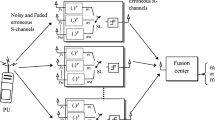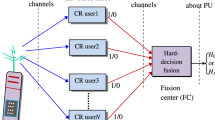Abstract
In a dynamic spectrum access (DSA) network, a secondary user (SU) that deploys a simple energy detector could access the unoccupied spectrum upon sensing the absence of primary signal. However, sensing accuracy could be compromised due to signal fading. For improved accuracy, cooperative spectrum sensing (CSS) has been proposed, where spectrum occupancy is decided based on the combined results from multiple SUs. Two combining techniques that are commonly used are equal gain combining (EGC) and selection combining (SC). In this paper, we investigate the performance of CSS that implements (i) EGC, and (ii) SC technique, over independent and identically distributed (i) Rician, and (ii) Nakagami fading channels, which can model fading conditions that are less or more severe than the commonly used Rayleigh distribution. Novel expressions for the probability of detecting primary signal, P d , have been derived and numerically evaluated.
Similar content being viewed by others
References
Urkowitz H. (1967) Energy detection of unknown deterministic signals. Proceedings of the IEEE 55(4): 523–531
Ghasemi, A., & Sousa, E. S. (2005). Collaborative spectrum sensing for opportunistic access in fading environments. In Proceedings of the DySPAN ’05, pp. 131–136.
Mishra, S. M., Sahai, A., & Brodersen, R. W. (2006). Cooperative sensing among cognitive radios. In Proceedings of the ICC’06.
Ghasemi A., Sousa E. S. (2007) Opportunistic spectrum access in fading channels through collaborative sensing. Journal of Communications 2(2): 71–82
Brennan D. G. (1959) Linear diversity combining techniques. Proceedings of the IRE 47: 1075–1102
Digham, F. F., Alouini, M.-S., & Simon, M. K. (2003). On the energy detection of unknown signals over fading channels. In Proceedings of the ICC ’03, pp. 3575–3579.
Yao Y.-D., Sheikh A. U. H. (1990) Outage probability analysis for microcell mobile radio systems with cochannel interferers in Rician/Rayleigh fading environment. Electronics Letters 26(13): 864–866
Taricco G. (2010) On the accuracy of the Gaussian approximation with linear cooperative spectrum sensing over Rician fading channels. IEEE Signal Processing Letters 17(7): 651–654
Yao Y.-D., Sheikh A. U. H. (1992) Investigations into cochannel interference in microcellular mobile radio systems. IEEE Transactions on Vehicular Technology 41(2): 114–123
Zhang, W., Yang, J., Yan, Q., & Xiao, L. (2010). Performance analysis of cooperative sensing with equal gain combination over Nakagami channels in cognitive radio networks. In Proceedings of the WiCOM’10, pp. 1–5.
Wang, Q., Yue, D.-W., & Wang, Y. (2009). Performance analysis of spectrum sensing using diversity technique. In Proceedings of the WiCOM ’09, pp. 1–5.
Gradshteyn I. S., Ryzhik I. M. (1994) Table of integrals, series, and products. Academic Press, San Diego
Nuttall A. H. (1975) Some integrals involving the Q M function. IEEE Transactions on Information Theory 21(1): 95–96
Proakis J. G. (2001) Digital communications. McGraw-Hill, New York
Tjhung T. T., Chai C. C., Dong X. (1995) Outage probability for a Rician signal in L Rician interferers. Electronics Letters 31(7): 532–533
Rappaport T. S. (2002) Wireless communications: Principles and practice. Prentice Hall, Upper Saddle River
Dong X., Beaulieu N. C. (2001) Average level crossing rate and average fade duration of selection diversity. IEEE Communications Letters 5(10): 396–398
Rabinowitz P., Weiss G. (1959) Tables of abscissas and weights for numerical evaluation of integrals of the form \({\int_0^\infty {e^{-x}x^{n}f(x)dx}}\) . MTAC 13(68): 285–294
Author information
Authors and Affiliations
Corresponding author
Rights and permissions
About this article
Cite this article
Foo, YL. Performance of Cooperative Spectrum Sensing Under Rician and Nakagami Fading. Wireless Pers Commun 70, 1541–1551 (2013). https://doi.org/10.1007/s11277-012-0764-6
Published:
Issue Date:
DOI: https://doi.org/10.1007/s11277-012-0764-6




